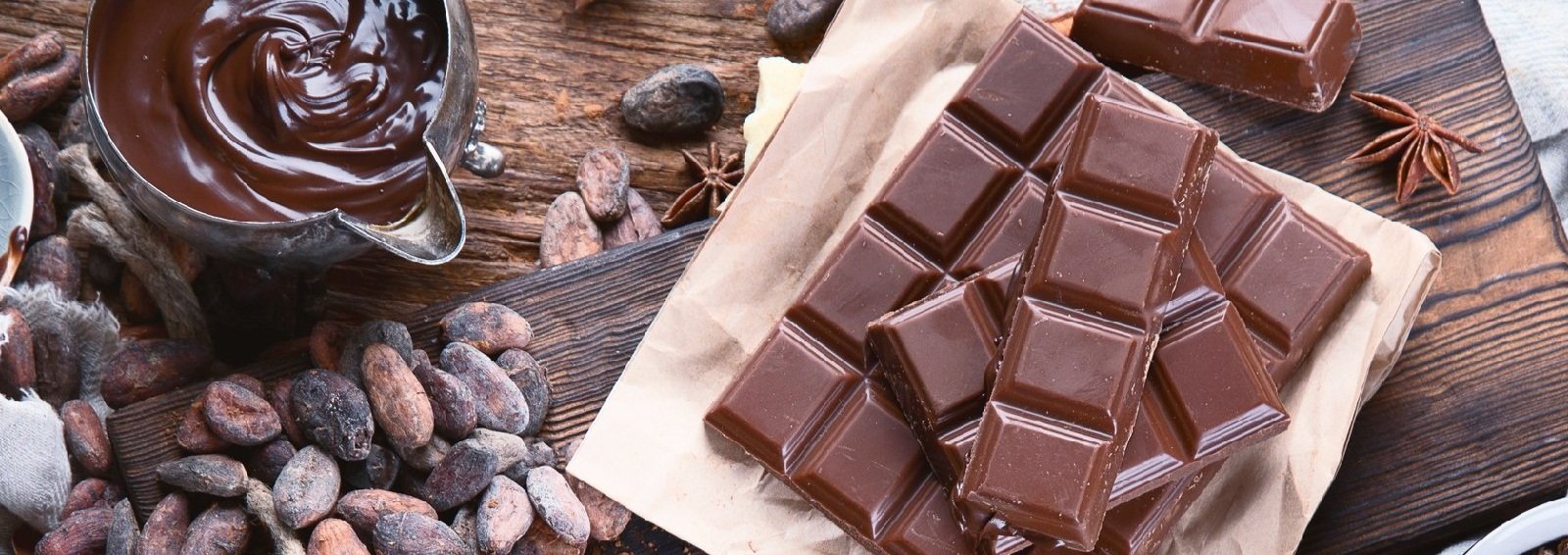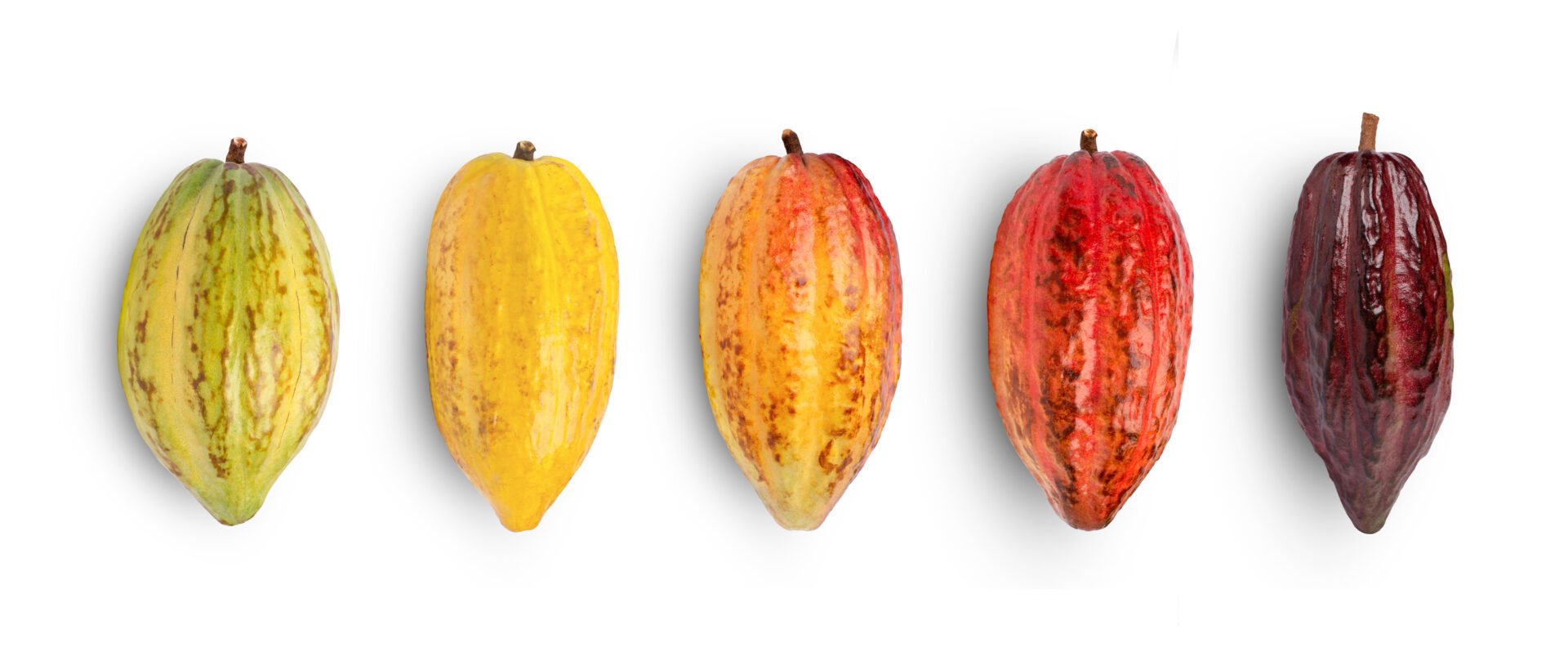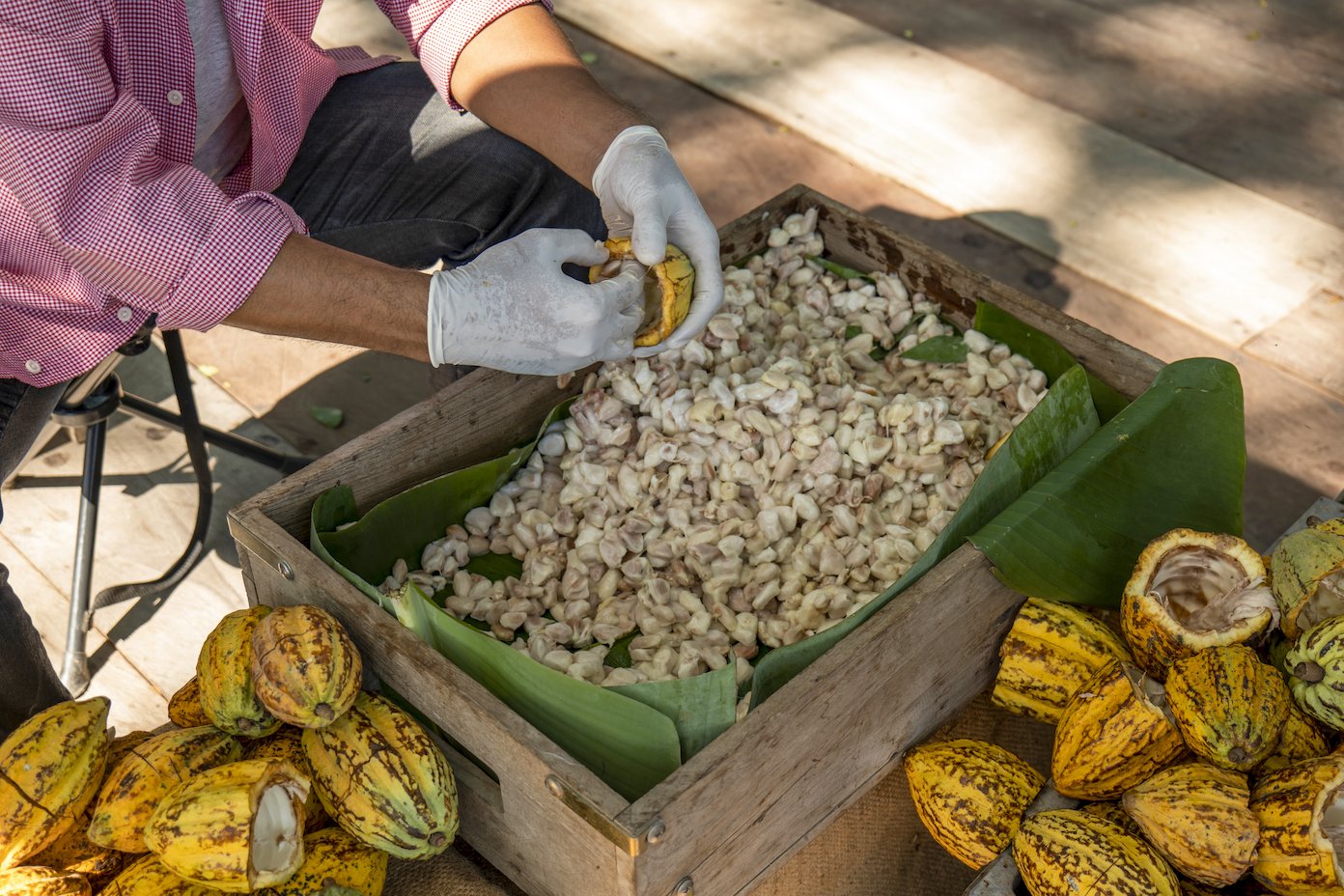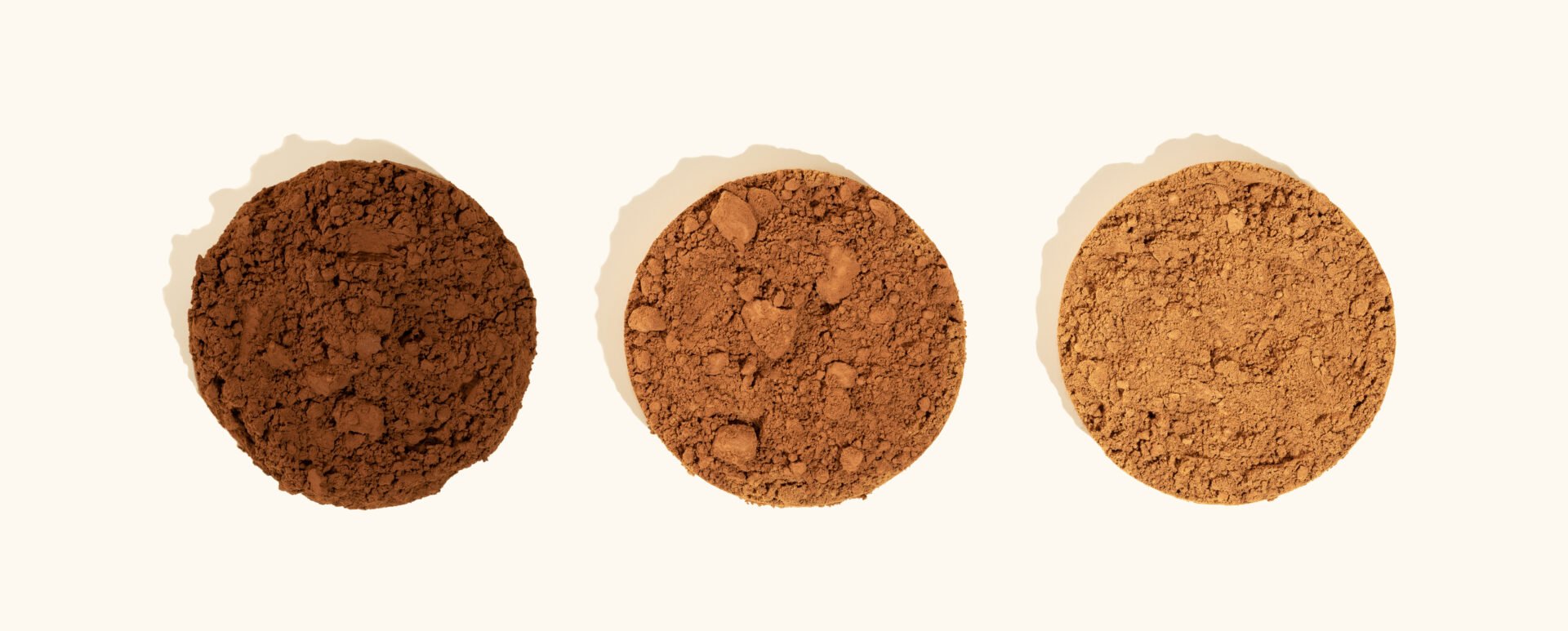From Bean to Bar: Secrets of the Cocoa Bean and Chocolate
Discover > Texas Home Cooking > From Bean to Bar: Secrets of the Cocoa Bean and Chocolate
You may think you know all there is to know about chocolate, but delve a little deeper, and you'll find a whole other world of cocoa beans and chocolate (What wine goes well with chocolate?) making.
Believe it or not, there are many secrets to making cocoa beans to chocolate beyond just melting down some chocolate bars (how long do chocolate bars last?). From the process of growing and harvesting the beans to the intricate steps of making chocolate from them, each step in the production chain impacts the final product's flavor and texture. Want to learn more? Just keep reading!
What is Chocolate?
Chocolate is produced from the seeds of an evergreen tree called Theobroma cacao, also known as the cacao tree. These trees have large pods of seeds called cocoa beans.
Raw cocoa beans are roasted, and ground then turned into a liquid called chocolate liquor. This liquor is then combined with sugar (how long does sugar last?), cocoa butter, (how long does cocoa butter last?) and milk to create different types of chocolate.
Chocolate is a delicious, cocoa-based food that has been enjoyed for centuries. Most Mesoamerican people - including the Mayas and Aztecs -- made chocolate beverages out of them as an ingredient in other foods or consumed it on its own!
Where Do Cocoa Beans Grow in the US?
Cocoa is a tropical plant that grows in hot, humid climates. Most cocoa beans are grown in Africa, where they are used to make chocolate. However, cocoa also grows in other parts of the world, including the Caribbean and South America.
While cocoa trees are not native to the United States, they can be found in some southern states, such as Florida and Hawaii. Unfortunately, cocoa requires a warm climate to thrive, so it is not commonly grown in more excellent areas of the country. However, responsibly, cocoa trees can be successfully cultivated in various climates.
The rise of West African countries, particularly Côte d'Ivoire and Ghana, in producing cocoa has been a significant factor accounting for 60% or more than half (55%) of global supply during the 21st century. African countries produce more than 3.5 million metric tons (3,900,000 long tons; 4,300,000 short tons) of raw cocoa beans annually. Ivory Coast produces approximately 30% of the world's cocoa, while Ghana produces about 20%. Indonesia and Cameroon are other significant producers.
Read about how Chocolates Dalila, craft chocolate makers in Houston, are doing their part to bring positive economic change in Venezuela.
Chocolate’s journey through time
1500
In the 1500s, the Europeans first encountered chocolate in Aztec Society. Chocolate cultivation has been traced back to the ancient Mayans and Aztecs. They believed that the cacao bean had magical powers. The prized beans were used as currency and were even given to newlyweds as a symbol of fertility.
The natives instinctively learned to brew a bitter, unsweetened beverage from the beans they had known to ferment and dry.
It was in 1528 when Hernando Cortes, a Spanish conquistador, discovered chocolate in Mexico and brought it back to Europe. It quickly became a luxurious imported good available only to royalty, nobility, and Catholic clergy.
1600
It wasn't until the late 1600s that chocolate began to be widely consumed in Europe. It was also used as a medicine and as a cooking spice.
1700
The Baker Chocolate Company was founded in Dorchester, Massachusetts, in 1765. They were the first company to produce chocolate in the country.
1800
In the early 1800s, a Dutch chemist and chocolate maker named Coenraad Johannes van Houten developed a process for removing cocoa butter from raw cocoa using a powerful press. This dutch process that grinds cacao beans is still used today.
In the late 1800s, Rodolphe Lindt invented the conching process that grinds cocoa paste into perfectly smooth chocolate. Since then, chocolate factories have popped up all over Europe and the United States.
1900
Milton Hershey invests everything he has in a chocolate factory in the cornfields of Dauphin County, Pennsylvania. The Hershey Company begins to mass produce and distributes milk chocolate bars.
Today, chocolate is one of the most popular food in the world.
Cacao Varieties
Like wine, raw cocoa beans can have different flavors depending on where they're grown. Fine varieties of cacao all taste very different. In fact, there are hundreds of flavor notes found in cacao.
There are four varieties of the bean, each with its unique flavor because of how it was cultivated in nature.
Forastero
Criollo
Trinitario
Nacional
Forastero
The Forastero variety, primarily cultivated in West Africa and Southeast Asia, is the most widely used because of its higher yield of cacao pods. It's also typically the hardier, more reliable strain known to produce beans with the most robust flavor. In addition, the forastero cocoa tree resists various diseases, making it cheaper to grow.
The forastero is generally used to make mass-produced chocolate. It accounts for nearly 80% of world production.
Criollo
Criollo is the preferred bean of chocolate connoisseurs, producing the highest quality out of all the cocoa varieties. They grow relatively mild beans that are aromatic.
Criollo only makes up less than 1 to 5% of the world's chocolate production. This is due to its fragile state and susceptibility to disease.
Trinitario
Trinitario is a Criollo and Forastero hybrid that makes up less than 10% of the total cocoa production. The delicate flavors and aroma of the Criollo greatly influence the complex flavors in this bean. It also boasts the same high yields and resistance to disease as the Forastero.
Nacional
The Nacional is a rare variety of cocoa beans considered by many European chocolatiers to be the most coveted source of cacao worldwide because of its floral aroma and complex flavor profile. This variety is found in areas of South America such as Ecuador and Peru.
Processing the Cocoa Kernel Into Chocolate - From Scratch!
Now that we've discussed the basics of cocoa kernels, it's time to process them into chocolate!
The cocoa kernel contains several important compounds, including cocoa butter and flavonoids. Therefore, processing raw cocoa beans into cocoa mass implies some stages, each of which can affect the final composition and quality of the product.
Step 1: Harvesting
When harvesting, make sure not to damage the trees' flowers to ensure more pods can continue to grow.
The first thing to do once harvested is to open the cacao pod. The cacao bean is located inside the white cacao pulp. The cacao beans are what you need to continue the next step of chocolate production. The other components can be repurposed into other products.
For a quicker process, you can purchase raw cacao beans and roast them yourself. If you want to skip a few more steps, you can buy cocoa nibs and proceed straight to step 6: grinding!
Step 2: Fermentation
Fermentation of raw cocoa beans is a process that helps to develop the flavor of chocolate. It begins as soon as the beans are exposed to oxygen.
To begin fermentation at home, place the beans between banana leaves and leave them in a warm place, between 100-120F. Similar to bread proofing!
The beans are fermented in traditional banana leaves or perforated wooden boxes. During this time, they are turned regularly to ensure even fermentation. The chemical changes that take place during fermentation start to develop the flavor of that cacao.
As the beans ferment, they produce their own heat, which speeds up the fermentation process.
The white pulp will break down into juice, so make sure to drain this often.
Step 3: Drying
After fermentation is the further drying of the beans. Drying is a crucial process in chocolate-making as it reduces the water content of the beans from about 60% to around 7%. This not only makes the beans easier to handle and store but also helps to prevent the growth of mold and other microorganisms.
You can continue drying them in the banana leaves or with a dehydrator. This step can take up to several days to complete.
Step 4: Roasting
The true flavor of the cacao develops during roasting. In addition, the temperature and degree of roasting play an essential role in the quality of the finished chocolate.
Beginners shouldn't get intimidated over roasting cocoa beans. Every chocolate maker has its own way of roasting its beans. This means there is no right or wrong way to obtain the target roast level.
You can start roasting the beans by first removing any beans with imperfections.
Then roast the beans in the oven at 250F until lightly roasted - around 15 to 20 minutes.
You can tell when the beans are roasted through their color, smell, taste, and popping noise.
Step 5: Winnowing
After roasting, peel the husks and break the beans into nibs. This is called winnowing.
Loosen the shell by pressing the beans between your fingers.
Break the beans down into individual nibs. Place all the beans into a bag and bash with a rolling pin or a mortar and pestle.
The broken particles of cocoa that result are called cocoa nibs. These nibs contain more than 50% fat in the form of cocoa butter and very little moisture.
Step 6: Grinding
Grinding the nibs produces a paste and releases the cocoa butter from inside the cell walls. This helps create a smooth, uniform texture in the final product. The paste is called chocolate liquor or cocoa mass and is the basis of chocolate production.
After the beans have been ground, they are mixed with other ingredients to create the chocolate mixture. The exact recipe will vary depending on the type of chocolate being made. Still, the cocoa mass is typically combined with powdered sugar, powdered milk, (how long does powdered milk last?) and cocoa butter.
You can do this in a high-speed blender or food processor. First, blend the beans and continue to process them into a paste.
Add your desired amount of powdered sugar and continue blending.
Don't use liquid sugar or add-ins! These can cause the chocolate to seize. Instead, we recommend powdered sugars and chocolate-specific flavorings to flavor the chocolate bar.
Step 7: Conching
Conching is where moisture and acidity are removed from the chocolate. This process eliminates undesirable odors and fully evolves the flavors and aromas of the chocolate. Conching plays a crucial role in the viscosity of chocolate. Higher-quality chocolates get their superior texture from longer conching.
Doing this step without the use of industrial chocolate-producing machines requires a bit of muscle work.
Heat a mortar and pestle in the oven for just a few minutes. Make sure it's warm but not too hot to touch.
You must manually grind the cocoa mass while adding cocoa butter to achieve a smoother, glossier texture.
Once satisfied with the flavor, you can proceed to the next step.
Step 8: Tempering
Tempering is the last critical step before chocolate can be consumed. By nature, chocolate is not shiny and smooth. Tempering removes the gritty texture and sull appearance from chocolates.
Tempering can be done manually in small batches. Manufacturers and large processors use precise thermostatically controlled equipment to automatically temper the chocolate to the required temperatures.
You can opt to skip this step and proceed to do it when needed. Store untempered chocolate in the chiller or freezer. Make sure the chocolate is wrapped tightly so it won't absorb other flavors or aromas.
And there you have it! That's how raw cocoa beans turn into the delicious chocolate we all enjoy. So now, all left is sitting back, relaxing, and enjoying a hot cup of hot cocoa!
The Different Types of Chocolates
Raw Chocolate
Raw chocolate is made from cacao beans that have not been roasted, and as a result, it retains more of the bean's natural flavor and nutrients. Raw chocolate also has a lower sugar content than regular chocolate.
Dark Chocolate
Dark chocolate contains liquor, sugar, cocoa butter, vanilla, and lecithin. This type of chocolate has no milk solids.
Mozna Chocolate is the only artisanal bean-to-bar chocolate factory in South Texas that crafts excellent and high-quality dark chocolate.
Milk Chocolate
Milk chocolate is made from cacao beans that have been roasted and then ground into a paste. Milk, cream, or condensed milk is added to the paste to create a smoother, sweeter flavor. Milk chocolates are generally sweeter than dark chocolate and have a lighter color with a less pronounced chocolate taste.
White Chocolate
White chocolate is made from cacao butter, (how long does cacao butter last?) milk, and sugar. It does not contain any cocoa solids, so it has a milder flavor than other types of chocolate. Since white chocolate contains no cocoa products at all, they are technically now chocolate.
Compound Chocolate
Compound chocolate has a lower cocoa content than other types of chocolate and do not have a strong chocolate flavor or an appealing mouth feel. They are cheaper than most chocolates and are often used in candy making.
Unsweetened Chocolate
Unsweetened chocolate, also known as bitter chocolate or baking chocolate (how long does baking chocolate last?), is made up of pure chocolate liquor. Unsweetened chocolate is best used for baking.
Couverture Chocolate
This type of chocolate contains high amounts of cocoa butter, which expedites the melting process and generally makes couverture smooth.
Ruby Chocolate
Barry Callebaut, a Belgian chocolatier, pioneered Ruby Chocolate. This chocolate type combines ruby cocoa beans with milk and sugar to create a rich chocolate flavor with berry notes.
Joy Chocolates is a bean-to-bar local business that makes chocolate bars (dark, white, malted, etc.)
The Chocolate Tasting Process
Chocolate makers distinguish different chocolates by altering the natural ingredients in the cocoa mass or adding additional elements into the mix. These ratios make chocolates distinct from each other. The best way to experience more than 400 flavor notes in cacao is by tasting them yourself.
The chocolate tasting process is a fun and easy way to learn about the different types of chocolate and their flavor profiles. By following these simple steps, you will be able to identify the critical characteristics of each type of chocolate and find your favorite.
1. Start by selecting a variety of chocolates to taste. You can choose milk, dark, white chocolate, or a combination of all three. It is best to select chocolates made from different cacao beans, as this will allow you to compare and contrast the flavors.
2. Break each chocolate into small pieces so that you can savor the flavor slowly.
3. Smell the chocolate before tasting it. This will help you identify some of the essential aromas.
4. Take a small bite of the chocolate and let it melt in your mouth. Pay attention to the texture, as well as the flavor.
5. Swallow the chocolate and take a sip of water. This will help cleanse your palate between tastings.
6. Repeat the process until you have tasted all of the chocolates.
7. Once you have finished, take a few moments to reflect on the flavors you experienced.
Indulge in some hand-made chocolates from artisan chocolatiers in Texas. Which chocolates were your favorites? Why did you like them?
What is Cocoa Powder and How is it Made?
Cocoa powder is a dried and powdered form of beans from the cacao tree. It is typically used in baking recipes as a way to add chocolate flavor, as well as for its health benefits.
Cocoa powder removes the nibs from the cacao beans and then grins them into a paste. The paste is then pressurized to extract the cocoa butter, which leaves a dry cake ground into a powder.
Cocoa powder is high in antioxidants and is linked to lower cholesterol levels and improved heart health. It is also a good source of fiber and magnesium.
Dutch-Processed Cocoa
Dutch processing is a method that mixes cocoa solids with an alkaline compound to reduce cocoa's natural acidity. The result is a less bitter taste and a darker color than natural cocoa.
The most common alkalizing agents used for this purpose include potassium carbonate, sodium carbonate, and/or sodium hydroxide. These produce colors ranging from light red all the way up to charcoal black, which you can get when combining them at higher temperatures (and possibly pressures).
What is Cocoa Butter?
Cocoa butter is a natural, creamy-white fat extracted from cocoa beans. It lowers the viscosity of melted chocolate by suspending and lubricating sugar particles.
Cocoa sets to a brittle consistency at average room temperature, making it responsible for chocolate's characteristic snap. It is generally the most expensive ingredient in chocolate due to the high cost of extraction.
Cocoa butter has a rich, chocolatey aroma and is often used as a flavoring agent in food products. It is also used in some pharmaceuticals and medical treatments.
Cocoa Bean Fun Facts for Kids!
1. Cocoa beans were once valued as money that literally grew on trees.
2. Cacao trees can live to be 100 years old but can only give beans for 25 years.
3. It takes 5 years for a cocoa tree to produce its first beans.
4. A cocoa tree has only around 2 pounds of chocolate in a year.
5. The first chocolate bar was created in 1847.
6. The entire world eats about two billion pounds of chocolate per year!
7. The Swiss consume more chocolate per capita than any other nation.
8. Dark chocolate is good for you because it's loaded with nutrients that improve your health and lower the risk of heart disease.
The Takeaway
Chocolate is a complex product with a long and exciting history. It all starts with the cocoa bean, which has some unique techniques that make chocolate so delicious. We hope you enjoyed this deep dive into chocolate and cocoa beans! What's your favorite type of chocolate?
Discover Texas local food shops and farmers markets where you can buy chocolate at great prices.











